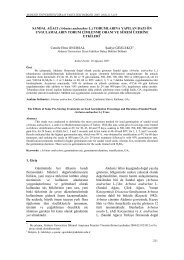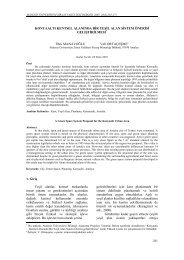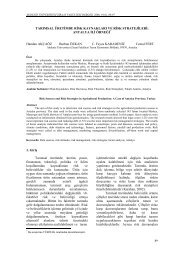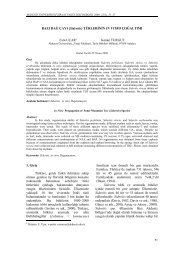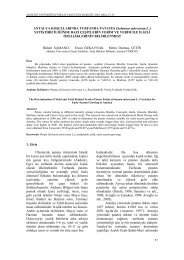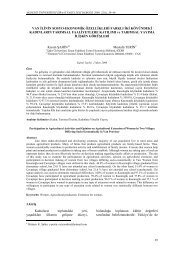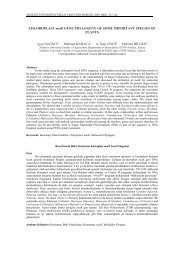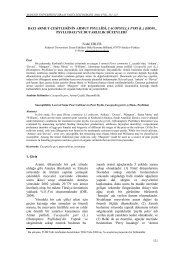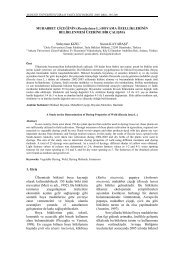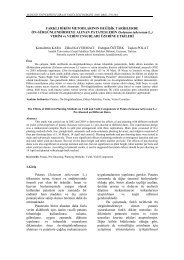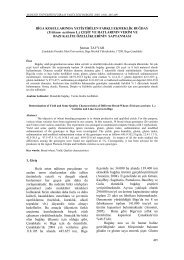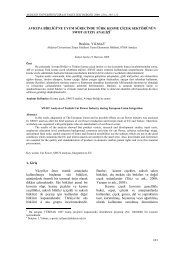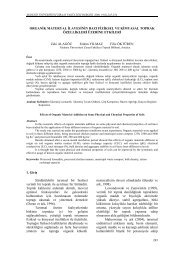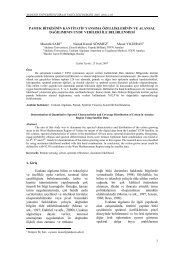A DIRECT RP-HPLC DETERMINATION OF PHENOLIC ...
A DIRECT RP-HPLC DETERMINATION OF PHENOLIC ...
A DIRECT RP-HPLC DETERMINATION OF PHENOLIC ...
You also want an ePaper? Increase the reach of your titles
YUMPU automatically turns print PDFs into web optimized ePapers that Google loves.
AKDENİZ ÜNİVERSİTESİ ZİRAAT FAKÜLTESİ DERGİSİ, 2006, 19(2),229-234<br />
A <strong>DIRECT</strong> <strong>RP</strong>-<strong>HPLC</strong> <strong>DETERMINATION</strong> <strong>OF</strong> <strong>PHENOLIC</strong> COMPOUNDS IN<br />
TURKISH RED WINES<br />
Gülcan ÖZKAN 1,<br />
Nilgün GÖKTÜRK BAYDAR 2<br />
1<br />
Süleyman Demirel University, Faculty of Agriculture, Department of Food Engineering, 32260 Isparta -Türkiye<br />
2<br />
Süleyman Demirel University, Faculty of Agriculture, Department of Horticulture, 32260 Isparta-Türkiye<br />
Abstract<br />
Red wines from four different Turkish grape cultivars were analyzed in order to determine their phenolic<br />
contents. For the analyses, reversed phase-high performance liquid chromatography (<strong>RP</strong>-<strong>HPLC</strong>) coupled with diode<br />
array detection was used. The concentrations of eight phenolic acid standards (ferulic, o-coumaric, p-coumaric,<br />
caffeic, syringic, trans-cinnamic, chlorogenic and gallic acids) and five flavonoid standards ((+)-catechin, (-)epicatechin,<br />
quercetin, vanillin and rutin) were used to determine characteristic differences among red wines from<br />
Kalecik karası, Öküzgözü, Boğazkere and Papazkarası cultivars grown in the viticultural region of Türkiye. In the<br />
wine samples, the most abundant phenolics (+)-catechin (17.82–33.59 mg L -1 ) as flavonoid and gallic acid (13.25-<br />
16.39 mg L -1 ) as phenolic acid while chlogenic acid was not detected in any samples. As a result, it was determined<br />
that types and concentrations of phenolics changed according to the wines from different cultivars.<br />
Keywords: Turkish wines, phenolic compounds, <strong>RP</strong>-<strong>HPLC</strong>, direct injection<br />
Türk Kırmızı Şaraplarında Fenolik Bileşiklerin Direkt <strong>RP</strong>-<strong>HPLC</strong> ile Belirlenmeleri<br />
Özet<br />
Dört farklı Türk üzüm çeşidinden yapılan kırmızı şaraplar, fenolik içeriklerini belirlemek amacıyla analiz<br />
edilmişlerdir. Analiz için diode array detectör eşliğinde ters fazlı-yüksek basınçlı sıvı kromotografisi (<strong>RP</strong>-<strong>HPLC</strong>)<br />
kullanılmıştır. Türkiye’de yetiştirilen Kalecik karası, Öküzgözü, Boğazkere ve Papazkarası üzüm çeşitlerinden elde<br />
edilen kırmızı şaraplar arasındaki karakteristik farkları belirlemek için, sekiz fenolik asit (ferulik, o-kumarik, pkumarik,<br />
kaffeik, siyringik, trans-sinnamik, klorogenik ve gallik asitler) ile beş flavonoid ((+)-kateşin, (-)-epikateşin,<br />
kuersetin, vanillin ve rutin) standartı kullanılmıştır. Şarap örneklerinde en fazla bulunan fenolikler, flavonoidlerden<br />
(+)-kateşin (17,82–33,59 mg L -1 ) ve fenolik asitlerden de gallik asit (13,25-16,39 mg L -1 ) olurken, klorogenik asit<br />
hiçbir şarap örneğinde belirlenememiştir. Sonuç olarak, fenolik maddelerin tip ve konsantarsyonlarının farklı<br />
çeşitlerden elde edilen şaraplara göre değiştiği belirlenmiştir.<br />
Anahtar kelimeler: Türk Şarapları, Fenolik Bileşikler, <strong>RP</strong>-<strong>HPLC</strong>, Direkt Enjeksiyon<br />
1. Introduction<br />
The phenolic compounds of red wines<br />
are substances which play an important role<br />
in several sensory properties such as colour,<br />
flavour, astringency and hardness<br />
(Rubichaud and Noble, 1990). Phenolics, a<br />
large and complex group of compounds of<br />
red wines, also serve as important oxygen<br />
reservoirs and substrates for browning<br />
reactions (Proestos et al., 2005).<br />
Furthermore its well known that wines are<br />
rich in phenolic compounds, which have<br />
been exhibited to be powerful antioxidants.<br />
Antioxidants play a crucial role in the<br />
prevention of many diseases such as cancer,<br />
inhibiting tumour initiation and heart disease<br />
(Briviba and Sies, 1994; Husain et al.,<br />
1987). These protective health effects<br />
derived from the consumption of wines have<br />
been attributed to their phenolic contents<br />
(Huang et al., 1992; Rice-Evans and Packer,<br />
1998).<br />
The types and concentrations of the<br />
phenolic compounds in wines depend on<br />
grape cultivars, ripening and climatic<br />
conditions (Goldberg et al., 1998). High<br />
performance liquid chromatography (<strong>HPLC</strong>)<br />
technique has been generally used in order<br />
to determinate the phenolic compounds in<br />
wine samples (Rosa, 1994; Revilla & Ryan,<br />
2000; Rodriguez-Delgado et al., 2001;<br />
Lopez et al., 2001). In the determination of<br />
the wine phenolics, different extraction<br />
methods including solid-phase extraction<br />
with C18 or strong anionexchange anionic<br />
cartridges, liquid-liquid extraction with<br />
different organic solvents have been used. In<br />
229
A Direct <strong>RP</strong>-<strong>HPLC</strong> Determination of Phenolic Compounds in Turkish Red Wines<br />
this study, wine samples injected directly to<br />
<strong>HPLC</strong>. So, the method permitted the<br />
determination of phenolic compounds in<br />
wines without any prior purification. Direct<br />
<strong>RP</strong>-<strong>HPLC</strong> injection techniques without<br />
sample preparation was used by Revilla and<br />
Ryan (2000), Lopez et al. (2001), Castellari<br />
et al. (2002), Ibern-Gomez et al. (2002), de<br />
Villiers et al. (2004), Suarez et al. (2005)<br />
before.<br />
Despite the wealth of information on<br />
wines in general, there appears to be little<br />
information on phenolic compounds of<br />
Turkish wines obtained from different grape<br />
cultivars. Therefore the aim of the study is to<br />
characterize the phenolic compounds of red<br />
Turkish wines by (<strong>RP</strong>) <strong>HPLC</strong> with DAD<br />
detector using the direct quantative<br />
determination and to compare the major<br />
differences among the red wines obtained<br />
from different cultivars.<br />
2. Materials and Methods<br />
230<br />
2.1. Wine Samples<br />
Three bottles of each different brands<br />
(Yazgan, Kavaklıdere and Doluca for<br />
Kalecik karası and Öküzgözü; Yazgan and<br />
Kavaklıdere for Boğazkere and Yazgan and<br />
Sevilen for Papaz karası) were purchased<br />
from a hypermarket in Isparta, Turkey.<br />
Before analyses, different brands of each<br />
wine were combined in equal volumes. The<br />
<strong>HPLC</strong> analysis was performed without any<br />
particular treatment except filtration. Each<br />
determination was carried out in triplicate.<br />
2.2. Standards<br />
Gallic acid, caffeic acid, p-coumaric<br />
acid, o-coumaric acid, ferulic acid, syringic<br />
acid, (−)-epicatechin, rutin and quercetin<br />
were purchased from Sigma-Aldrich<br />
(Steinheim, Germany). Trans-cinnamic acid<br />
and vanillin were obtained from Acros<br />
(Geel, Belgium) while (+)-catechin and<br />
chlorogenic acid were supplied from Fluka<br />
(Buchs, Switzerland). Stock solutions of all<br />
the standards were prepared in methanol.<br />
2.3. <strong>HPLC</strong> Analysis<br />
Phenolic compounds were evaluated<br />
by reversed phase - high performance liquid<br />
chromatography (<strong>RP</strong>-<strong>HPLC</strong>) with direct<br />
injection. Detection and quantification was<br />
carried out with a SCL-10Avp System<br />
controller, a SIL–10AD vp Autosampler, a<br />
LC-10AD vp pump, a DGU-14a degasser, a<br />
CTO-10 A vp column heater and a diode<br />
array detector with wavelengths set at 278<br />
nm. The 250 x 4,6 mm i.d., 5µm column<br />
used was filled with Luna Prodigy. The<br />
flow rate was 1 ml min -1 , injection volume<br />
was 10 µl and the column temperature was<br />
set at 30 °C. Gradient elution of two solvents<br />
was used: Solvent A consisted of: acetic–<br />
water (2:98 v/v), solvent B: methanol and<br />
the gradient programme used is given Table<br />
1. The data were integrated and analyzed<br />
using the Shimadzu Class-VP<br />
Chromatography Laboratory Automated<br />
Software system. The wine samples,<br />
standard solutions and mobile phases were<br />
filtered by a 0.45-µm pour size membrane<br />
filter. The amount of phenolic compounds in<br />
the extracts was calculated as µg/l wine<br />
using external calibration curves, which<br />
were obtained for each phenolic standard.<br />
Phenolic compositions of wines were<br />
determined by the modified method of<br />
Capanio et al. (1999).<br />
Table 1. Solvent gradient conditions with<br />
linear gradient<br />
Final Time A% B%<br />
(Initial) 100 0<br />
3 95 5<br />
18 80 20<br />
20 80 20<br />
30 75 25<br />
40 70 30<br />
50 60 40<br />
55 50 50<br />
65 0 100<br />
2.4. Statistical analysis<br />
Statistical analysis was performed<br />
using SPSS 10.01 software for windows.
3. Results and Discussion<br />
Reversed phase high-performance<br />
liquid chromatography (<strong>RP</strong>-<strong>HPLC</strong>) with<br />
direct injection was used for separation of<br />
phenolic compounds. Although normalphase<br />
chromatography has been used for the<br />
separation of phenolic compounds, it is now<br />
generally agreed that reversed-phase <strong>HPLC</strong><br />
is the method of choice for the separation of<br />
a wide variety of phenolic compounds. The<br />
separation of standards of phenolic<br />
compounds is shown in Figure 1. As can be<br />
seen separation was achivied for 13<br />
components including phenolic acids and<br />
G. ÖZKAN, N. GÖKTÜRK BAYDAR<br />
flavonoids. Generally, such separations are<br />
rapid and provide high resolution and<br />
sensitivity (Lopez et al., 2001). Phenolic<br />
contents of four Turkish grape wines (mg L -<br />
1 ) were shown in Table 2. Levels of<br />
phenolic compounds were significantly<br />
influenced by the wine grape cultivars<br />
(P
A Direct <strong>RP</strong>-<strong>HPLC</strong> Determination of Phenolic Compounds in Turkish Red Wines<br />
all wine samples. Proestos et al. (2005) were<br />
also found the most abundant phenolic<br />
compounds in Greek wines as (+)-catechin<br />
(11.80-40.00 mg L -1 ). On the other hand in<br />
this study, chlorogenic acid was not detected<br />
in any wine samples.<br />
In Boğazkere wine, eleven<br />
compounds were separated (Figure 2).<br />
While, only o-coumaric acid and<br />
chlorogenic acid were not found, main<br />
compounds of it were (+)-catechin, gallic<br />
acid, caffeic acid, (-)-epicatechin, rutin,<br />
quercetin and p-coumaric acid, respectively.<br />
Papaz karası wine had all phenolic<br />
compounds identified in this study except<br />
rutin and chlorogenic acid. In wine from<br />
Öküzgözü, ten of phenolic compounds were<br />
identified as (+)-Catechin (22.26 mg L -1 ),<br />
gallic acid (14.93 mg L -1 ), caffeic acid<br />
(11.55 mg L -1 ), (-)-epicatechin (9.46 mg L -<br />
1 ), quercetin (2.20 mg L -1 ), p-coumaric acid<br />
(2.11 mg L -1 ), syringic acid (1.55 mg L -1 ),<br />
vanillin (1.03 mg L -1 ), o-coumaric acid (0.64<br />
mg L -1 ), trans-cinnamic acid (0.30 mg L -1 ).<br />
Ferulic acid, chlorogenic acid and rutin were<br />
no in this wine sample. While syringic,<br />
ferulic, chlorogenic acid and trans-cinnamic<br />
acids in Kalecik karası wine was not found,<br />
rutin (14.92 mg L -1 ) was the second most<br />
abundant compound after (+)-catechin<br />
232<br />
(33.59 mg L -1 ). Gallic acid, (-)-epicatechin,<br />
caffeic acid and quercetin followed them,<br />
respectively. Vanillin and o-coumaric acid<br />
were determined lower amount in it. These<br />
differences may be explained by the<br />
differences among the cultivars which may<br />
affect phenolic compositions. The findings<br />
of Oszmianski and Lee (1990), Andrade et<br />
al. (2001), Lopez et al. (2001), Lopez-Velez<br />
et al. (2003), Proestos et al. (2005) studying<br />
phenolic compounds of wines making from<br />
different grape cultivars are in agreement<br />
with our results. Similarly, Kılınç and<br />
Kalkan (2003) determined that the<br />
evaluation of phenolic contents in white and<br />
red wines emphasized the importance of<br />
variety characteristics of wines. They found<br />
phenolic acids including gallic acid, phydroxybenzoic<br />
acid, syringic acid, 2,3dihydroxybenzoic<br />
acid, ferrulic acid, pcoumaric<br />
acid and vanillic acid) in 13<br />
different wines. Bayhan (2004) studying on<br />
the phenolic compositions of wines<br />
produced 16 different Kalecik karası clones<br />
found that catechin, epicatechin, quercetin<br />
and trans-resveratrol levels of wines ranged<br />
from 2.2 mg L -1 to 9.27 mg L -1 , 4.36 mg L -1<br />
to 8.83 mg L -1 , 4.52 mg L -1 to 15.2 mg L -1<br />
and 0 to 4.18 mg L -1 , respectively.<br />
Figure 2. A Chromatogram recorded at 278 nm of the Boğazkere wine sample: 1-Gallic acid, 2-(+)-<br />
Catechin, 4-Caffeic acid, 5-Syringic acid, 6-(-)-Epicatechin, 7-Vanillin, 8- p-Coumaric acid, 9- Ferulic<br />
acid, 11-Rutin, 12- Trans-Cinnamic acid, 13- Quercetin.<br />
Data presented in a manner to<br />
accomplish a fundamental objective is to<br />
compare the concentration of each phenolic<br />
compounds in wines from the different<br />
grape cultivars. Researches conducted on the<br />
compositions of phenolics in wines, are
generally focused on the concentrations of<br />
resveratrol and anthocyanidins (Kallithraka<br />
et al., 2001; Tsanova-Savova et al., 2002;<br />
Gambelli and Santaroni, 2004; Kolouchova<br />
et al., 2004; Zhou et al, 2004; de Villiers et<br />
al., 2004; Villano et al., 2005; Abril et al.,<br />
2005).<br />
According to our knowledge, there are<br />
no detailed data regarding the composition<br />
of phenolic compounds in Turkish wine<br />
obtained several grape cultivars, so this<br />
preliminary study contributes new<br />
knowledge of the composition of the wines<br />
of different grapes. Further studies, with a<br />
larger number of samples, are necessary to<br />
confirm the differences observed.<br />
References<br />
Abril, M., Negueruela, A.I., Pérez, C., Juan, T. and<br />
Estopanan, G., 2005. Preliminary Study of<br />
Resveratrol Content in Aragón Red and Rosé<br />
Wines. Food Chemistry, 92(4): 729-736.<br />
Andrade, P. B., Mendes, Falco, G.V., Valentão, P. and<br />
Seabra, R. M., 2001. Preliminary Study of<br />
Flavonols in Port Wine Grape Varieties Food<br />
Chemistry, : 397-399.<br />
Bayhan, A., 2004. Determination of some phenolic<br />
compounds by using GC-MS methods in wines<br />
produced from different kalecik karası clones.<br />
Ankara University, p 37, Master Thesis.<br />
Briviba, K. and Sies, H., 1994. Nonenzymathic<br />
Antioxidant Defence Systems. In: B. Frei<br />
(Editor), Natural Antioxidant in Human Health<br />
and Disease. Academic Press Inc., New York,<br />
USA, pp. 107-128.<br />
Caponio, F., Alloggio, V. and Gomes, T., 1999.<br />
Phenolic Compounds of Virgin Olive<br />
Oil:Influence of Paste Preparation Techniques.<br />
Food Chemistry, 64: 203-209.<br />
Castellari M., Sartini E., Fabiani A., Arfelli G. and<br />
Amati A., 2002. Analysis of Wine Phenolics by<br />
High Performance Liquid Chromatography<br />
Using a Monolithic Type Column. Journal of<br />
Chromatography A, 973 (1-2): 221-227.<br />
De Villiers A., Vanhoenacker G., Majek P. and Sandra<br />
P., 2004. Determination of Anthocyanins in<br />
Wine by Direct Injection Liquid<br />
Chromatography-Diode Array Detection-Mass<br />
Spectrometry and Classification of Wines Using<br />
Discriminant Analysis. Journal of<br />
Chromatography A, 1054 (1-2): 195-204.<br />
Gambelli, L. and Santaroni, G. P., 2004. Polyphenols<br />
Content in Some Italian Red Wines of Different<br />
Geographical Origins. Journal of Food<br />
Composition and Analysis, 17(5): 613-618.<br />
Goldberg, D.M., Karumanchiri, A., Tsang, E., and<br />
Soleas, G.J., 1998. Catechin and epicatechin<br />
concentrations of red wines: Regional and<br />
cultivar-related differences. American Journal<br />
G. ÖZKAN, N. GÖKTÜRK BAYDAR<br />
of Enology and Viticulture, 49: 23-34.<br />
Huang, M., Ho, C. and Lee, C.,1992. Phenolic<br />
Compounds in Foods and Their Effects on<br />
Health. American Chemical Society, Washington,<br />
USA.<br />
Husain, S.R., Cillart, J. and Cillart, P., 1987. Hydroxy<br />
Radical Scavenging Activity of Flavonoids.<br />
Phytochemistry, 26 (9): 2489-2491.<br />
Ibern-Gomez M., Andres-Lacueva C., Lamuela-<br />
Raventos R.M. and Waterhouse A.L., 2002.<br />
Rapid <strong>HPLC</strong> Analysis of Phenolic Compounds<br />
in Red Wines. American Journal of Enology And<br />
Viticulture, 53 (3): 218-221.<br />
Kallithraka, S., Arvanitoyannis, I., El-Zajouli, A. and<br />
Kefalas, P., 2001. The Application of an<br />
Improved Method for Trans-Resveratrol to<br />
Determine the Origin of Greek Red Wines. Food<br />
Chremistry, 75: 355-363.<br />
Kılınç, E. and Kalkan, H., 2003. High-performance<br />
Liquid Chromatographic Determination of Some<br />
Phenolic Acids of Turkish Commercial Wines:<br />
An Electrochemical Approach Journal of Wine<br />
Research, 14 (1): 17–23.<br />
Kolouchova-Hanzlíkova, H., Melzoch, K., Filip, V.<br />
and Smidrkal J., 2004. Rapid Method for<br />
Resveratrol Determination by <strong>HPLC</strong> with<br />
Electrochemical and UV Detections in Wines.<br />
Food Chemistry, 87(1): 151-158.<br />
Lopez, M., Martinez, F., Del Valle, C. and Miro, M.,<br />
2001. Analyses of Phenolic Consistents of<br />
Biological Interest in Red Wines by High<br />
Performance Liquid Chromatography. Journal of<br />
Chromatography A, 922: 359-363.<br />
Lopez-Velez, M., Martinez, F. and Del Valle, C.,<br />
2003. The Study of Phenolic Compouınds as<br />
Natural Antioxidants in Wine. Critical Reviews<br />
in Food Science And Nutrition, 43 (3): 233-244.<br />
Oszmianski, J. and Lee, C.Y., 1990. Isolation and<br />
<strong>HPLC</strong> Determination of Phenolic Compounds in<br />
Red Grapes. American Journal of Enology and<br />
Viticulture, 41 (3): 204-206.<br />
Proestos, C., Bakogiannis, A., Psarianos, C., Koutinas,<br />
A.A., Kanellaki, M. and Komaitis, M., 2005.<br />
High Performance Liquid Chromatography<br />
Analyses of Phenolic Substances in Greek. Food<br />
Control, 16: 319-323.<br />
Revilla, E. and Ryan, J.M., 2000. Analyses of Several<br />
Phenolic Compounds with Potential Antioxidant<br />
Properties in Grape Extracts and Wines by High<br />
Performance Liquid Chromatography-<br />
Photodiode Array Detection without Sample<br />
Preperation. Journal of Chromatography A, 881:<br />
461-469.<br />
Rice-Evans, C. and Packer, L., 1998. Flavonoids in<br />
Health And Disease. Marcel Dekker, New York,<br />
USA.<br />
Rodriguez-Delgado, M.A., Malovana, S., Perez, J.P.,<br />
Borges, T. and Garcia Montelongo, F.J., 2001.<br />
Seperation of Phenolic Compounds by High<br />
Performence Liquid Chromatography with<br />
Absorbance and Fluoritmetric Detection. Journal<br />
of Chromatography A, 912: 249-257.<br />
Rosa, M., Raventos, L. and Waterhouse, A.L., 1994. A<br />
Direct <strong>HPLC</strong> Separation of Wine Phenolics.<br />
233
A Direct <strong>RP</strong>-<strong>HPLC</strong> Determination of Phenolic Compounds in Turkish Red Wines<br />
American Journal of Enology and Viticulture,<br />
45(1): 1-5.<br />
Rubichaud, J.L. and Noble, A.C., 1990. Astringency<br />
and Bitterness of Selected Phenolics in Wine.<br />
Journal of the Science of Food and Agriculture,<br />
53: 343-353.<br />
Suarez B., Palacios N., Fraga N. and Rodriguez R.,<br />
2005. Liquid Chromatographic Method for<br />
Quantifying Polyphenols iIn Ciders by Direct<br />
Injection. Journal of Chromatography A, 1066<br />
(1-2): 105-110.<br />
Tsanova-Savova, S., Dimov, S. and Ribarova, F.,<br />
2002. Anthocyanins and Color Variables of<br />
234<br />
Bulgarian Aged Red Wines. Journal of Food<br />
Composition and Analysis, 15 (6): 647-654.<br />
Villano, D., Fernandez-Pachon, M.S., Troncoso, A.M.<br />
and Garcia-Parrilla, M.C., 2005. Comparison of<br />
Antioxidant Activity of Wine Phenolic<br />
Compounds and Metabolites In Vitro. Analytica<br />
Chimica Acta, 538 (1-2): 391-398.<br />
Zhou, J., Cui, H., Wan, G., Xu, H., Pang, Y. and<br />
Duan, C., 2004. Direct Analysis of Trans-<br />
Resveratrol in Red Wine by High Performance<br />
Liquid Chromatography with Chemiluminescent<br />
Detection .Food Chemistry, 88 (4): 613-620.



